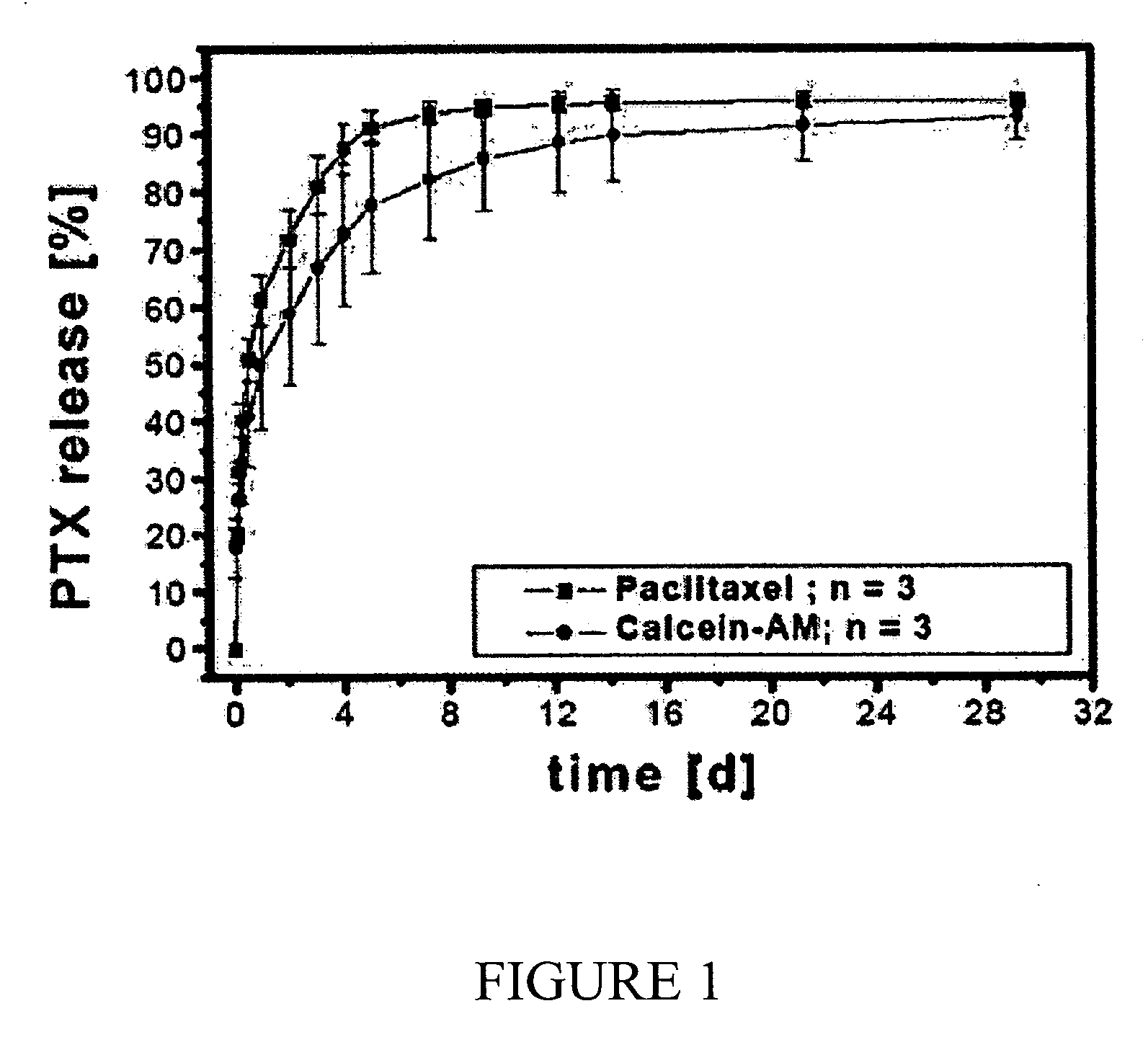Composition comprising an agent providing a signal, an implant material and a drug
- Summary
- Abstract
- Description
- Claims
- Application Information
AI Technical Summary
Benefits of technology
Problems solved by technology
Method used
Image
Examples
example 1
[0200] A commercially available, X-ray dense, non-fluorescing coronary stent from Fortimedix Company (KAON Stent), Netherlands, 18.5 mm long, and made of stainless steel 316L was coated with a coating of carbon-Si composite material in accordance with German Patent No. DE 202004009060U. A phenoxy resin obtained from UCB Company, Beckopox EP 401, was used as a precursor polymer, and a dispersion of commercially available Aerosil R972 (obtained from Degussa) in methylethylketone was prepared. The solids content of the polymer amounted to 0.75 wt %, the solids content of Aerosil in the dispersion was 0.25 wt %, and the solids content of solvent was 99 wt %. The precursor solution was sprayed onto the substrate as a polymer film and tempered by application of hot air at 350° C. in ambient air. The crude weight of the polymer film was subsequently determined, and the coating was found to have a surface area weight of about 2.53 g / m2. The sample was then examined in a Nikon fluorescence m...
example 2
[0201] As in Example 1, a commercially available, X-ray dense, non-fluorescing coronary stent from Fortimedix Company (KAON Stent), Netherlands, 18.5 mm long and made of 316L stainless steel was coated with a coating of carbon-Si composite material in accordance with the disclosure of German Patent No. DE 202004009060U. The composition of the precursor in this example was modified to modify the fluorescence emission spectrum in the red region. A phenoxy resin from UCB Company, Beckopox EP 401, was used as the precursor polymer, and it was combined with a dispersion of commercially available Aerosil R972 (from Degussa) in methylethylketone. Additionally, isophorone diisocyanate (from Sigma Aldrich Company) was introduced as a cross-linking agent. The solids content of the polymer amounted to 0.55 wt %, the solids content of Aerosil was 0.25 wt %, the solids content of the cross-linking agent was 0.2 wt %, and the solid portion of solvent was 99 wt %. The precursor solution was spraye...
example 3
[0203] The coronary stents produced in Example 1 and Example 2 above were subsequently charged with an active agent. Paclitaxel, obtained from Sigma Aldrich, was used as model substance. A Paclitaxel solution having a concentration of 43 g / l was prepared in ethanol. The stents were subjected to a gravimetric analysis before and after being charged by dipping in 5 ml of the ethanolic paclitaxel solution. The charge was carried out by dipping the stent in the active agent solution for 10 minutes. The overall charge was determined from the increase in mass after the dipping step. The sample from Example 1 had a loading of 0.766 g / m2, and the sample from Example 2 had a loading of 0.727 g / m2. After drying each stent in air for 60 minutes, another fluorescence microscopy investigation was carried out, which showed the same fluorescence characteristics as was observed for the unloaded porous coatings (strong blue and green fluorescence and weak red fluorescence sample for the stent of Exa...
PUM
 Login to View More
Login to View More Abstract
Description
Claims
Application Information
 Login to View More
Login to View More - R&D
- Intellectual Property
- Life Sciences
- Materials
- Tech Scout
- Unparalleled Data Quality
- Higher Quality Content
- 60% Fewer Hallucinations
Browse by: Latest US Patents, China's latest patents, Technical Efficacy Thesaurus, Application Domain, Technology Topic, Popular Technical Reports.
© 2025 PatSnap. All rights reserved.Legal|Privacy policy|Modern Slavery Act Transparency Statement|Sitemap|About US| Contact US: help@patsnap.com

